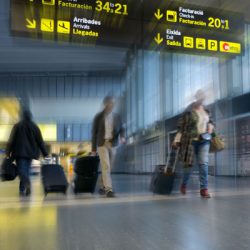Issue 4’s Guide to Self-Service Technologies
How can an airport efficiently implement self-service processes without facing significant costs?
List view / Grid view


‘Seamless travel’ is a term frequently being used to describe the optimum passenger experience, meaning a traveller can complete the entire airport journey without experiencing delays, disruption or confusion.
Self-service technology, predictive analysis, artificial intelligence, real-time information and data-sharing are just some of the digital concepts airports around the world are deploying in an attempt to achieve a seamless passenger experience.
International Airport Review, within this core topic, endeavours to provide case studies on how airports from all corners of the world are working on improving their passengers’ experience. This covers both inside the terminal, and initiatives implemented outside of the terminal that focus on ensuring the passengers’ arrival to the airport is as easy as possible.
This is a key theme in the airport industry that must not be overlooked: As passenger expectations evolve, an airport’s response must do so too.
How can an airport efficiently implement self-service processes without facing significant costs?
The new touchless technology removes the need for passengers to hand travel documents to agents during the security screening.
Start-ups from across the globe can apply for Aena's programme to develop technology to improve the passenger experience at airports.
An installed mobile application, health assessment form and quarantine pledge agreement are mandatory requirements for arrival in Qatar.
By introducing image recognition technology, passengers will be able to check in baggage at Eindhoven Airport more seamlessly.
12 August 2020 | By Veovo
During this webinar Martin Bowman, Deloitte’s Director of Aviation Digital Assets, looked at the far-reaching implications of COVID-19 on operational planning. He also explored what new approaches will be needed to adapt to a world where constraints are higher and uncertainty is prevalent. Veovo CEO, James Williamson, considered the ingredients…
The TSA at Tampa International Airport have introduced nine CAT units in order to provide passengers with a touchless journey through the airport.
As a result of COVID-19, airports across the globe have been forced to adapt operations in order to ensure the health safety of passengers and staff. The Vancouver Airport Authority’s new health and safety programme at Vancouver International Airport – TAKEcare – is working to keep passengers safe and restore…
This issue covers how COVID-19 is set to change the aviation ecosystem for the foreseeable, alongside surface access, new appointments and the One ID project.
Designed to support those with disabilities that are not visible or immediately noticeable, the scheme is now in effect at Teesside International Airport.
Under renovation since early 2016, the new departure areas at the two terminals of Osaka Airport feature a heavy focus on retail and F&B.
Kansai International Airport has installed 12 e-gates, offering a new and smoother passenger experience when entering airport security.
New self-service baggage drop-off stations are to be implemented at Vilnius Airport, details Dainius Čiuplys, Director of Vilnius Airport, to decrease check-in times.
Passengers who require additional support can now sign up to receive a personalised, step-by-step tour of Winnipeg Richardson International Airport (YWG) before they fly.
The new technology will enable JFKIAT’s operations team to monitor passenger social distancing and overcrowding throughout the terminal as part of its COVID-19 response.